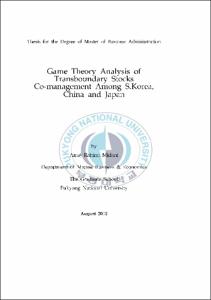Game Theory Analysis of Transboundary Stocks Co-management Among S.Korea, China and Japan
- Alternative Title
- 한․중․일간 경계왕래성 어종의 공동 관리에 대한 게임이론 분석
- Abstract
- In this study we try to understand the optimal way to manage the transboundary fishery resources jointly owned by South Korea, China and Japan. They already started making steps in the progress of cooperation among themselves but still couldn’t reach to any fundamental cooperation. A dynamic model of fisheries is combined with Nash’s theory. To prevent the model from being more complex we assume the costs of three countries are equal. A conflict among these countries arising from differences in perception of the social discount rate is examined. The case is considered in which three countries can and can’t make a side or transfer payments to one another. Also we will not go over the historical or political conflicts that countries had with each other. According to Article 63 of the U.N. convention, if each coastal countries unable to cooperate in the management of resources, they should go its own way and manage the segment of the resource within its EEZ. By considering this article, we can simply say that each of these countries would have two simple strategies to pursue, Conserve or deplete. Since harvesting costs are independence of the size of the resource, the resource could be reduced to zero.
The depletion of stocks is dangerous for all these countries; this is why we decided to analyze the reasons using a game theory and answer why they couldn’t reach to cooperation yet. Scientists are well aware of these problems and they are trying to bring these three countries together but because of discount rates differences they were not able to start cooperation.
Among three countries, Korea is at the mid-stage level in terms of fishery development. So, South Korea needs to play an important and vital role in this cooperation. However, three countries are in different situations concerning the use of resources and fishery development stages so it is not easy to achieve a cooperative fishery management. In most studies of joint management (Kaitala and Pohjola 1988; Munro1979) the cooperation is described by the Nash solution. There are however an infinite number of possible cooperative solutions (Roth 1979; Peters1992) as well as cooperative compensatory solutions. It is assumed that each country manager’s goal will be to maximize his country’s benefits from the fishing sector. Gulland points out that there are two levels of cooperation, primary level and secondary level. The primary level consists of cooperation in research, without coordinated management. Since all countries should stand to benefit from improved information and data, the cooperation should be relatively easy to achieve. It is impossible to achieve cooperation at this primary level; it certainly will not be possible to achieve cooperation in active management of transboundary resources. In actual cooperative management regimes, which have proven to be successful, cooperation in research alone is often seen.
Here a simple example using Prisoner Dilemma is used to show why these three countries felt the need of cooperation among themselves. On the second part we analyze what level these three countries are right now and how they can make effective cooperation. To Optimal their cooperation we try to use Nash theory and analyze the differences between their discount rates and other important factors.
- Issued Date
- 2012
- Awarded Date
- 2012. 8
- Type
- Dissertation
- Publisher
- 부경대학교
- Alternative Author(s)
- 아마즈 라히미 미다니
- Affiliation
- 부경대학교 대학원
- Department
- 대학원 해양산업경영학과
- Advisor
- 이상고
- Table Of Contents
- I. Introduction 1
1. Background 1
2. Co-management among South Korea, China, Japan 3
3. Objectives of study 6
II. Methodology 10
1. Background 10
2. The management of transboundary fish stocks 14
3. Non-Cooperative management of a transboundary fishery resource among South Korea, China and Japan 15
4. Levels of cooperation in transboundary resource management among South Korea, China and Japan 18
5. Cooperative management of transboundary resources 24
Ⅲ. Game theory analysis on resource management among three countries 28
1. Introduction 28
2. Three Countries efforts to reach to cooperation 33
3. Mackerel information for three countries 44
4. Cooperative Game for South Korea, China and Japan 48
4-1. The basic model 48
4-2. Discount rate 52
5. New analysis 58
5-1. Accountability & Transparency 60
5-2. Adaptability, Flexibility, Efficiency 60
5-3. Eco-System Based Management 61
6. Case Study of Transboundary fisheries 62
6-1. Canada & USA Co-management 62
6-2. Iceland & Greenland co-management 66
6-3. Norway & Russia co-management 69
7. Regional Fisheries Management Organizations 72
Ⅳ. Conclusion 74
References 79
Appendix 86
- Degree
- Master
- Files in This Item:
-
-
Download
 Game Theory Analysis of Transboundary Stocks Co-management Among S.Korea, China and Japan.pdf
기타 데이터 / 4.54 MB / Adobe PDF
Game Theory Analysis of Transboundary Stocks Co-management Among S.Korea, China and Japan.pdf
기타 데이터 / 4.54 MB / Adobe PDF
-
Items in Repository are protected by copyright, with all rights reserved, unless otherwise indicated.